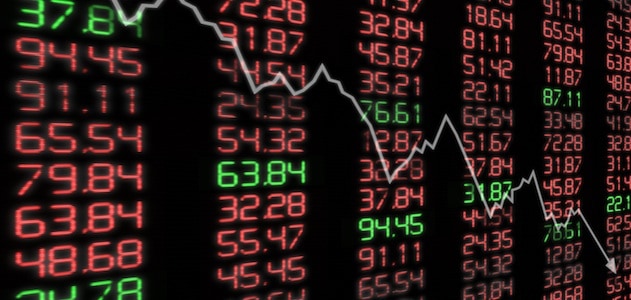
Stocks plunged in the first major sell-off in six years, sending investors to the safety of bonds — ironically the very market that started the wild sell off and volatility across financial markets.
In one day, the Treasury market went from a source of acute pain to a safe haven for investors panicked by a rapid loss in stock market value. Rising bond yields last week triggered a stock market selloff that accelerated Monday, with a 1,500 point decline in the Dow at one point.
The dramatic market purge sent the Dow temporarily down to correction levels — more than 10 percent from its all-time high of 26,616, reached in January. The Dow closed at 24,342 down 1,178 or 4.6 percent – 8.5 percent from its high.
At its worst, the S&P 500 fell Monday to a low of 2,637, a decline of more than 100 points, before closing at 2,648, a drop of 4.1 percent, its worse day since August, 2011. The S&P 500 is now off 7.8 percent from its January high.
The quick and sudden rise in Treasury yields last week came amid concern rising inflation expectations would force the Federal Reserve to speed up interest rate hikes. But the stock market’s behavior, including a 666-point Dow decline Friday, created a buying spree in bonds, which took the 10-year yield from a morning high of 2.88 percent all the way down to 2.70 percent.
“To some extent, this will put an end to that,” said Jim Caron, Morgan Stanley Investment Management fixed income portfolio manager. Caron said during all of last year, stocks and bonds rose together, a relationship that was out of sorts. In a normal environment, stocks don’t normally rise when bonds do, and bonds would normally be priced lower when economic news is positive.
“We’re reasserting that balance right now, the balance we haven’t had for the last couple of years,” he said. “It feels really painful right now because you’re giving back in the market in terms of performance, and everything else. It’s like a Super Bowl binge. You go heavy Sunday, and the next day you have a salad.”
Market expectations for Fed interest rate hikes also faded. Last week, the market was betting on possibly four hikes, and now the derivatives market is pricing in less than the three rate hikes the Fed forecast for this year. The Fed
“I think it’s healthy in a way. It’s like taking the band aid off quick. Equities got too far ahead of themselves. Bond yields got higher. Equities were supposed to respond to that in January but in January we had record equity inflows,” said Caron.
Caron said as both markets sold off, the dollar became a beneficiary from investors moved to cash. The dollar index was up 0.5 percent at 89.55.
Sam Stovall, CFRA chief equity strategist, said he now sees a 14 percent total decline for the S&P 500 to about 2,534, near its 200-day moving average. He expects a sharp and swift correction but does not see the stock market heading into a bear market, which would be a 20 percent decline.
“I think investor optimism got too far ahead of the fundamentals and looking at market valuations in conjunction with inflation, points to an overvaluation in the mid- to low-teens,” said Stovall.
The stock market’s violent spasms Monday rattled investors, as the Dow dropped hundreds of points at a time in afternoon trading.
“It’s just all electronic trading right now. There’s no kind of panic on my desk right now. It’s just falling out of bed. It’s crazy,” said a trader at major Wall Street trading house during the wild swings.
Scott Redler, partner with T3Live.com, said the market sell off accelerated when the S&P 500 broke its 50-day moving average at about 2,715.
“We broke the 50-day. All the machines triggered. People pulled bids, and that’s what created that air pocket,” said Redler. “There was also a big put spread bet, which might have spooked people. Some body bought a lot of puts betting the market would go down.”
Redler said the next level to watch is the 2,637, the day’s low, to see if it can hold in Tuesday’s session. “The game changed last week, and now it’s pretty much confirmed…The question is not what happened but what happens next,” he said.
Strategists pointed to the fact the stock market tried to stabilize after opening sharply lower but it’s subsequent plunge was a big negative for a market that has now lost more than 6 percent from its highs on S&P 500.
“It means it’s likely the correction could go on for days,” said Art Cashin, director of floor operations at UBS.
In the bond market, the focus is on equities, but also on this week’s auctions. The Treasury offers $26 billion 3-year notes Tuesday.
“Bonds sold off, so stocks got scared, and now bonds are scared of stocks,” said Aaron Kohli, fixed income strategist at BMO. Kohli said there should be demand for the 3-year, which is reflective of Fed hiking.
